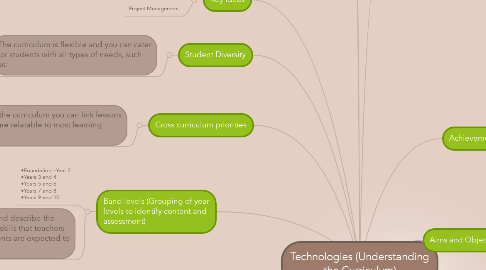
1. Content Stucture
1.1. This is broken down into two subjects
1.1.1. Design and Technologies
1.1.2. Digital Technologies
2. Strands
2.1. Knowledge and Understanding
2.2. Processes and Production Skills
3. Band levels (Grouping of year levels to identify content and assessment)
3.1. •Foundation –Year 2 •Years 3 and 4 •Years 5 and 6 •Years 7 and 8 •Years 9 and 10.
3.2. Content descriptions at each band describe the knowledge, understanding and skills that teachers are expected to teach and students are expected to learn
3.2.1. Content elaborations further explain content descriptions. i.e. break them up.
4. Cross curriculum priorities
4.1. Topics in the curriculum you can link lessons too, that are relatable to most learning areas.
4.1.1. •Aboriginal and Torres Strait Islander histories and cultures
4.1.2. •Asia and Australia’s engagement with Asia
4.1.3. •Sustainability
5. Student Diversity
5.1. The curriculum is flexible and you can cater for students with all types of needs, such as:
5.1.1. Students with a disability
5.1.2. English as an additional language or dialect
5.1.3. Gifted and Talented Students
6. Key Ideas
6.1. Creating preferred futures
6.2. Project Management
7. Study Ladder Resource https://dtm4260.edublogs.org/?p=3275&preview=true
8. Puppet Pals Resource: https://dtm4260.edublogs.org/?p=3170&preview=true
9. Aims and Objectives
9.1. We aim to teach knowledge, understanding and skills for students to:
9.1.1. •investigate, design, plan, manage, create and evaluate solutions
9.1.2. •are creative, innovative and enterprising when using traditional, contemporary and emerging technologies, and understand how technologies have developed over time
9.1.3. •make informed and ethical decisions about the role, impact and use of technologies in the economy, environment and society for a sustainable future
9.1.4. •engage confidently with and responsibly select and manipulate appropriate technologies − materials, data, systems, components, tools and equipment − when designing and creating solutions
9.1.5. •critique, analyse and evaluate problems, needs or opportunities to identify and create solutions.
10. Achievement Standards
10.1. An achievement standard describes the quality of learning (the depth of conceptual understanding and the sophistication of skills) that would indicate the student is well-placed to commence the learning required at the next level of achievement.
10.1.1. Example: By the end of Year 2, students identify how common digital systems (hardware and software) are used to meet specific purposes. They use digital systems to represent simple patterns in data in different ways.
11. General Capabilities
11.1. The seven capabilities students need to be skilled with to live in the 21st century. These are across all learning areas.
11.1.1. Literacy
11.1.2. Numeracy
11.1.3. Information and communication technology (ICT) capability
11.1.4. Critical and creative thinking
11.1.5. Personal and Social capability
11.1.6. Ethical understanding
11.1.7. Intercultural Understanding
12. Links to other learning areas
12.1. You can link this area of the curriculum to other learning areas such as:
12.1.1. Enlgish
12.1.2. Mathematics
12.1.3. Science
12.1.4. History
12.1.5. Geography
12.1.6. The Arts
12.1.7. Health and Physical Education
12.1.8. Economics and Business
